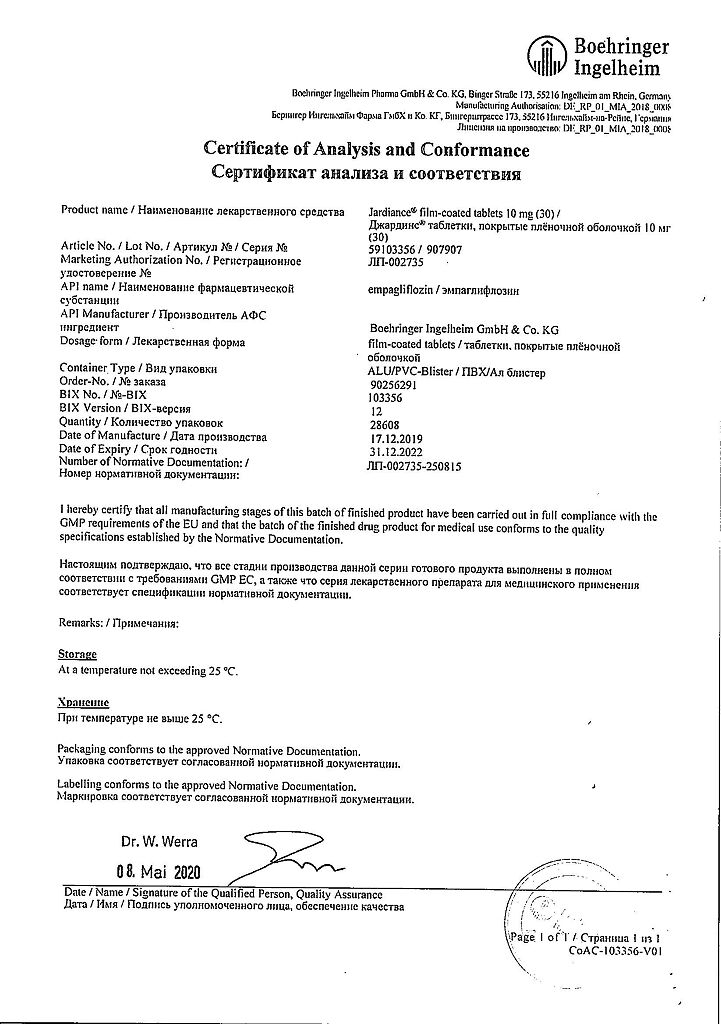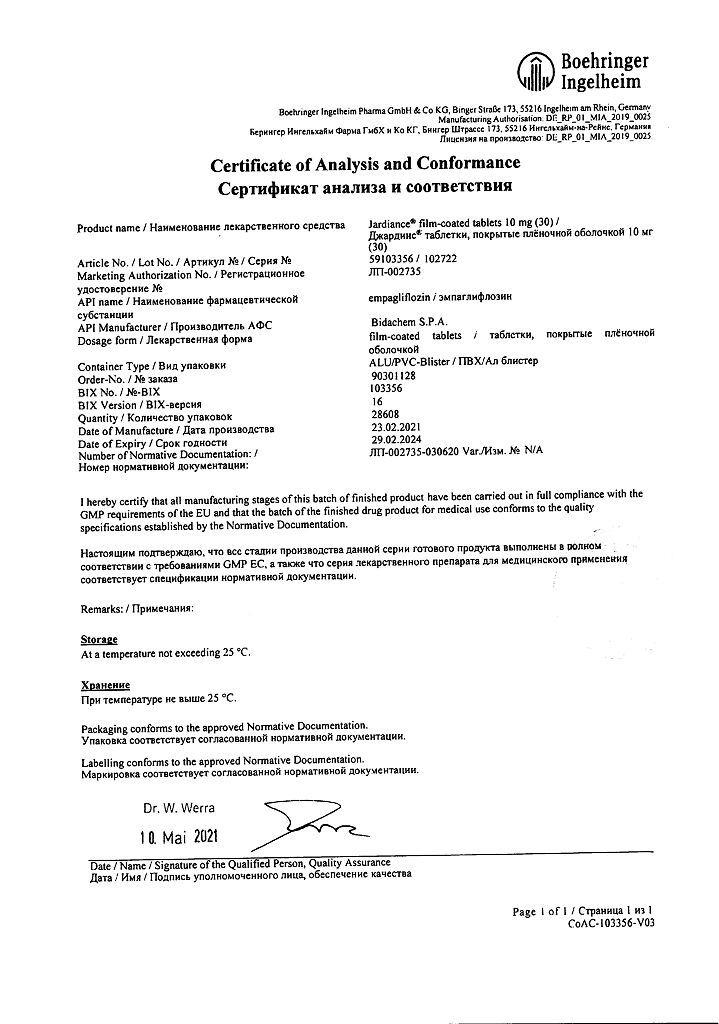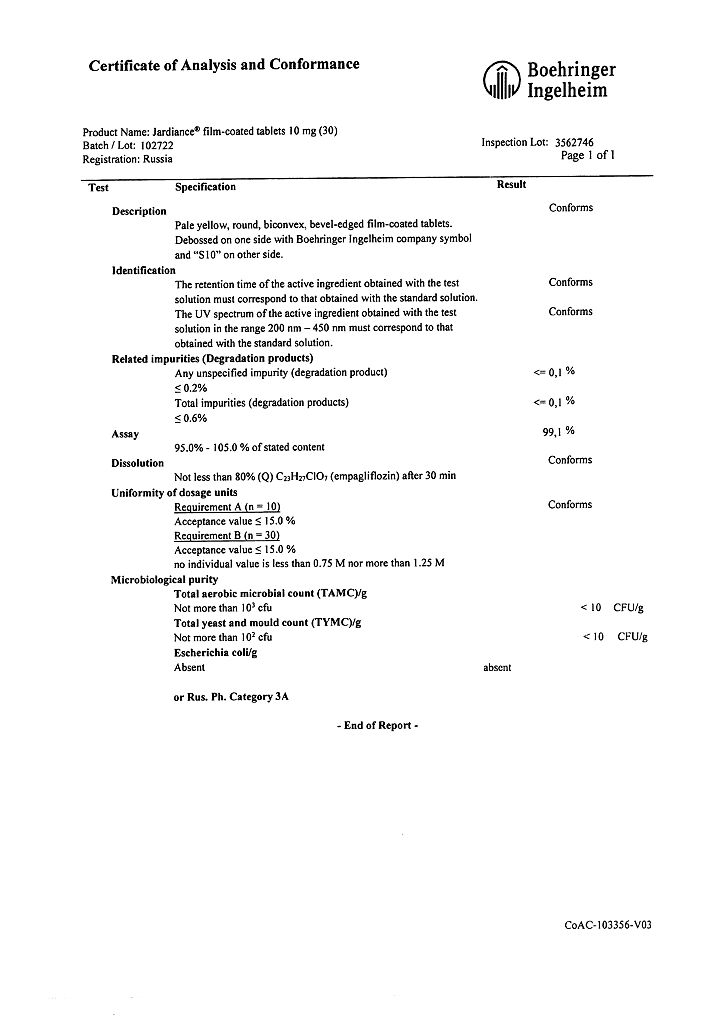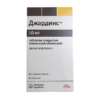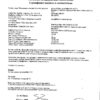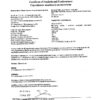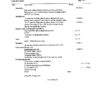No products in the cart.
Jardins, 10 mg 30 pcs.
€83.08 €69.23
Description
Empagliflozin is a reversible, highly active, selective and competitive inhibitor of the sodium-dependent glucose transporter type 2 with a concentration value of 1.3 nmol required to inhibit 50% of enzyme activity (IC50). The selectivity of empagliflozin is 5000 times greater than that of the type 1 sodium-dependent glucose transporter responsible for glucose absorption in the intestine. In addition, empagliflozin was found to be highly selective against other glucose transporters responsible for glucose homeostasis in various tissues.
The sodium-dependent glucose transporter type 2 is the main glucose transporter protein responsible for reabsorption of glucose from the renal glomeruli back into the bloodstream. Empagliflozin improves glycemic control in patients with type 2 diabetes mellitus (type 2 DM) by reducing glucose reabsorption in the kidneys. The amount of glucose excreted by the kidneys through this mechanism depends on blood glucose concentration and glomerular filtration rate (GFR). Inhibition of type 2 sodium-dependent glucose transporter in patients with DM2 and hyperglycemia leads to excretion of excess glucose by the kidneys.
In clinical studies, it was found that in patients with DM 2, renal glucose excretion increased immediately after the first dose of empagliflozin; this effect lasted for 24 hours. The increase in renal glucose excretion persisted until the end of the 4-week treatment period, averaging about 78 g/day when empagliflozin was used in a dose of 25 mg once daily. In patients with DM 2, increased renal excretion of glucose led to an immediate decrease in plasma glucose concentrations.
Empagliflozin decreases plasma glucose concentrations both when taken on an empty stomach and after meals.
The insulin-independent mechanism of action of empagliflozin contributes to a low risk of possible hypoglycemia.
The effect of empagliflozin does not depend on the functional state of pancreatic beta cells and insulin metabolism. A positive effect of empagliflozin on surrogate markers of beta-cell function, including NOMA-ß index (homeostasis-B model) and proinsulin to insulin ratio, has been noted. In addition, additional glucose excretion by the kidneys causes caloric loss, which is accompanied by a decrease in adipose tissue volume and body weight.
Glucosuria observed during use of empagliflozin is accompanied by a slight increase in diuresis, which may contribute to a moderate decrease in blood pressure.
In clinical trials where empagliflozin was used as monotherapy; combination therapy with metformin; combination therapy with metformin and sulfonylurea derivatives; combination therapy with metformin versus glimepiride; combination therapy with pioglitazone +/- metformin; as combination therapy with dipeptidyl peptidase-4 (DPP-4) inhibitor, metformin +/- another hypoglycemic oral medication; as combination therapy with insulin, a statistically significant decrease in glycosylated hemoglobin HbAlc and decrease in fasting plasma glucose concentration has been demonstrated.
Indications
Indications
Diabetes mellitus type 2:
as monotherapy in patients with inadequate glycemic control only on the background of diet and exercise, the administration of metformin to whom is considered inappropriate due to intolerance;
as a combination therapy with other hypoglycemic agents, including insulin, when the therapy used together with diet and exercise does not provide the necessary glycemic control.
Pharmacological effect
Pharmacological effect
Empagliflozin is a reversible, highly active, selective and competitive inhibitor of sodium glucose transporter type 2 with a concentration required to inhibit 50% of enzyme activity (IC50) of 1.3 nmol. The selectivity of empagliflozin is 5000 times greater than the selectivity of sodium-dependent glucose transporter type 1, responsible for the absorption of glucose in the intestine. In addition, empagliflozin was found to be highly selective for other glucose transporters responsible for glucose homeostasis in various tissues.
Sodium-dependent glucose transporter type 2 is the primary transport protein responsible for the reabsorption of glucose from the glomeruli back into the bloodstream. Empagliflozin improves glycemic control in patients with type 2 diabetes mellitus (T2DM) by reducing renal glucose reabsorption. The amount of glucose excreted by the kidneys through this mechanism depends on the concentration of glucose in the blood and the glomerular filtration rate (GFR). Inhibition of sodium-dependent glucose transporter type 2 in patients with type 2 diabetes and hyperglycemia leads to the excretion of excess glucose by the kidneys.
In clinical studies, it was found that in patients with type 2 diabetes, renal glucose excretion increased immediately after the first dose of empagliflozin; this effect lasted for 24 hours. The increase in renal glucose excretion persisted until the end of the 4-week treatment period, averaging approximately 78 g/day with empagliflozin 25 mg once daily. In patients with type 2 diabetes, an increase in renal glucose excretion led to an immediate decrease in plasma glucose concentrations.
Empagliflozin reduces plasma glucose concentrations both when taken on an empty stomach and after meals.
The insulin-independent mechanism of action of empagliflozin contributes to a low risk of possible hypoglycemia.
The effect of empagliflozin does not depend on the functional state of pancreatic beta cells and insulin metabolism. Positive effects of empagliflozin on surrogate markers of beta cell function, including HOMA-ß (Homeostasis Model-B) index and proinsulin-to-insulin ratio, were noted. In addition, additional excretion of glucose by the kidneys causes a loss of calories, which is accompanied by a decrease in the volume of adipose tissue and a decrease in body weight.
Glucosuria observed during the use of empagliflozin is accompanied by a slight increase in diuresis, which may contribute to a moderate decrease in blood pressure.
In clinical studies using empagliflozin as monotherapy; combination therapy with metformin; combination therapy with metformin and sulfonylurea derivatives; combination therapy with metformin versus glimepiride; combination therapy with pioglitazone +/- metformin; in the form of combination therapy with a dipeptidyl peptidase-4 (DPP-4) inhibitor, metformin +/- another hypoglycemic oral drug; in the form of combination therapy with insulin, a statistically significant decrease in glycosylated hemoglobin HbAlc and a decrease in fasting plasma glucose concentration was proven.
Special instructions
Special instructions
JARDINS is not recommended for use in patients with type 1 diabetes mellitus or for the treatment of diabetic ketoacidosis.
The maximum daily dose of JARDINS contains 113 mg of lactose, so the drug should not be used in patients with rare hereditary disorders such as lactase deficiency, lactose intolerance, glucose-galactose malabsorption.
Clinical studies have shown that treatment with empagliflozin does not increase cardiovascular risk. The use of empagliflozin at a dose of 25 mg does not prolong the QT interval.
When JARDINS is co-administered with sulfonylureas or insulin, a reduction in the sulfonylurea/insulin dose may be required due to the risk of hypoglycemia.
Combinations of hypoglycemic drugs that have not been studied
Empagliflozin has not been studied in combination with glucagon-like peptide 1 (GLP-1) analogues.
Monitoring kidney function
The effectiveness of JARDINS depends on kidney function. Therefore, it is recommended to monitor renal function before prescribing it and periodically during treatment (at least once a year), as well as before prescribing concomitant therapy that may adversely affect renal function. Patients with renal failure (GFR less than 45 ml/min). taking the drug is not recommended.
Elderly patients
Patients aged 75 years or older have an increased risk of dehydration. These patients receiving empagliflozin were more likely to experience adverse reactions due to hypovolemia (compared to patients receiving placebo). Experience with empagliflozin in patients over 85 years of age is limited; therefore, JARDINS is not recommended for use in patients over 85 years of age.
Use in patients at risk of developing hypovolemia
According to the mechanism of action, taking the drug JARDINS can lead to a moderate decrease in blood pressure. Therefore, the drug should be used with caution in cases where a decrease in blood pressure is undesirable, for example, in patients with cardiovascular diseases; patients taking antihypertensive drugs (with a history of arterial hypotension), as well as in patients over 75 years of age.
If a patient taking the drug JARDINS. conditions that can lead to fluid loss develop (for example, in diseases of the gastrointestinal tract), the patient’s condition, blood pressure, and hematocrit and electrolyte balance should be carefully monitored. It may be necessary to temporarily stop taking the drug until water balance is restored.
Urinary tract infections
The incidence of side effects such as urinary tract infections was comparable with empagliflozin 25 mg and placebo, and higher with empagliflozin 10 mg. Complicated urinary tract infections (such as pyelonephritis and urosepsis) were reported at similar rates in patients treated with empagliflozin and placebo. If complicated urinary tract infections develop, temporary discontinuation of empagliflozin therapy is necessary.
Laboratory analysis of urine
According to the mechanism of action, glucose is detected in the urine in patients taking JARDINS.
Impact on the ability to drive vehicles and machinery
Clinical studies on the effect of empagliflozin on the ability to drive vehicles and operate machinery have not been conducted. Patients should be careful when driving vehicles and machinery, as hypoglycemia may develop when using the drug JARDINS (especially in combination with sulfonylurea derivatives and/or insulin).
Active ingredient
Active ingredient
Empagliflozin
Composition
Composition
Active substance:
empagliflozin – 10 mg.
Excipients:
lactose monohydrate – 162.5 mg,
microcrystalline cellulose – 62.5 mg,
hyprolose (hydroxypropylcellulose) – 7.5 mg,
croscarmellose sodium – 5 mg,
colloidal silicon dioxide – 1.25 mg,
magnesium stearate – 1.25 mg.
Shell composition:
opadry yellow (02B38190) – 7 mg (hypromellose 2910 – 3.5 mg, titanium dioxide – 1.733 mg, talc – 1.4 mg, macrogol 400 – 0.35 mg, iron dye yellow oxide – 0.018 mg).
Contraindications
Contraindications
type 1 diabetes mellitus;
diabetic ketoacidosis;
rare hereditary disorders (lactase deficiency, lactose intolerance, glucose-galactose malabsorption);
renal failure with persistent GFR <45 ml/min/1.73 m2;
use in combination with glucagon-like peptide-1 analogues (due to the lack of data on efficacy and safety);
pregnancy;
lactation period (breastfeeding);
age over 85 years;
children and adolescents under 18 years of age (due to insufficient data on effectiveness and safety);
hypersensitivity to any component of the drug.
With caution: patients at risk of developing hypovolemia (use of antihypertensive drugs with a history of arterial hypotension); for gastrointestinal diseases leading to fluid loss; genitourinary system infections; use in combination with sulfonylurea derivatives or insulin; low carbohydrate diet; history of diabetic ketoacidosis; low secretory activity of pancreatic β-cells; patients over 75 years of age.
Side Effects
Side Effects
The overall incidence of adverse events was similar in patients receiving empagliflozin or placebo in clinical studies. The most common adverse reaction was hypoglycemia, observed when empagliflozin was used in combination with sulfonylureas or insulin.
Adverse reactions observed in patients receiving empagliflozin in placebo-controlled studies are presented below according to organ system classification and MedDRA Preferred Terms and their absolute frequency. Frequency categories are defined as follows: very common (≥1/10), common (≥1/100 to <1/10), uncommon (≥1/1,000 to <1/100), rare (≥1/10,000 to <1/1000), or very rare (<1/10,000); Adverse reactions are also highlighted, the frequency of which is unknown (cannot be estimated based on the available data).
Infectious and parasitic diseases: often – vaginal candidiasis, vulvovaginitis, balanitis and other genital infections, urinary tract infections.
Metabolism and nutrition: very often – hypoglycemia (when used together with sulfonylurea derivatives or insulin).
From the cardiovascular system: infrequently – hypovolemia.
From the urinary system: often – frequent urination; infrequently – dysuria.
From the skin and subcutaneous tissues: often – itching.
Description of selected adverse reactions
Hypoglycemia
The incidence of hypoglycemia depended on the concomitant hypoglycemic therapy used and was similar in patients receiving empagliflozin or placebo as monotherapy, as well as in the case of empagliflozin added to metformin and in the case of empagliflozin added to pioglitazone (±metformin).
When empagliflozin was used in combination with metformin and a sulfonylurea, and when empagliflozin was used in combination with insulin (+/- metformin and +/- sulfonylurea), the incidence of hypoglycemia was higher than when using placebo in the same combination.
Severe hypoglycemia (a condition requiring medical intervention): The incidence of severe hypoglycemia was low (< 1%) and similar in patients receiving empagliflozin and placebo as monotherapy, when empagliflozin was added to metformin, and when empagliflozin was added to pioglitazone (±metformin). When empagliflozin was used in combination with metformin and sulfonylureas, in combination with insulin (+/- metformin and +/- sulfonylurea), the incidence of hypoglycemia was higher than when using placebo in the same combination.
Frequent urination
Frequency of urination (measured by symptoms such as pollakiuria, polyuria, nocturia) was higher with empagliflozin (10 mg dose: 3.5%, 25 mg dose: 3.3%) than with placebo (1.4%). The incidence of nocturia was comparable in the group of patients taking empagliflozin and in the group of patients taking placebo (less than 1%). The intensity of these side effects was mild to moderate.
Urinary tract infections
The incidence of urinary tract infections was similar with empagliflozin 25 mg and placebo (7.0% and 7.2%, respectively), but higher with empagliflozin 10 mg (8.8%). As with placebo, urinary tract infections with empagliflozin were more common in patients with a history of chronic or recurrent urinary tract infections. The incidence of urinary tract infections was similar in patients taking empagliflozin and placebo. Urinary tract infections were more common in women.
Genital infections
The incidence of adverse events such as vaginal candidiasis, vulvovaginitis, balanitis and other genital infections was higher with empagliflozin (10 mg dose: 4.0%, 25 mg dose: 3.9%) than with placebo (1.0%). Genital infections were more common in women. The intensity of genital infections was mild or moderate.
Hypovolemia
The incidence of hypovolemia (expressed as decreased blood pressure, orthostatic hypotension, dehydration, syncope) was similar with empagliflozin (10 mg dose: 0.6%, 25 mg dose: 0.4%) and placebo (0.3%). In patients over the age of 75 years, the incidence of hypovolemia was comparable in patients taking empagliflozin 10 mg (2.3%) and placebo (2.1%), but higher in patients taking empagliflozin 25 mg (4.3%).
Interaction
Interaction
Pharmacodynamic interaction
Empagliflozin may enhance the diuretic effect of thiazide and loop diuretics, which, in turn, may increase the risk of dehydration and hypotension.
Insulin and drugs that increase insulin secretion, such as sulfonylureas, may increase the risk of hypoglycemia. Therefore, when using empagliflozin simultaneously with insulin and drugs that enhance its secretion, it may be necessary to reduce their dose to avoid the risk of hypoglycemia.
Pharmacokinetic interaction
In vitro assessment of drug interactions. Empagliflozin does not inhibit, inactivate or induce CYP450 isoenzymes. The main pathway of metabolism of empagliflozin in humans is glucuronidation with the participation of uridine 5′-diphospho-glucuronosyltransferases UGT2B7, UGT1A3, UGT1A8 and UGT1A9. Empagliflozin does not inhibit UGT1A1, UGT1A3, UGT1A8, UGT1A9, or UGT2B7. Drug interactions between empagliflozin and drugs that are substrates of the CYP450 and UGT1A1 isoenzymes are considered unlikely.
Empagliflozin is a substrate for P-glycoprotein and breast cancer resistance protein (BCRP), but does not inhibit these proteins at therapeutic doses. Based on data obtained from in vitro studies, it is believed that empagliflozin is unlikely to interact with drugs that are substrates for P-glycoprotein.
Empagliflozin is a substrate for the organic anion transporters OAT3, OATP1B1 and OATP1B3, but is not a substrate for organic anion transporter 1 (OAT1) and organic cationic transporter 2 (OCT2). However, drug interactions between empagliflozin and drugs that are substrates for the transporter proteins described above are considered unlikely.
In vivo assessment of drug interactions. When empagliflozin was co-administered with other commonly used drugs, no clinically significant pharmacokinetic interactions were observed. The results of pharmacokinetic studies indicate that there is no need to change the dose of Jardins® when used simultaneously with commonly used drugs.
The pharmacokinetics of empagliflozin is not altered in healthy volunteers when co-administered with metformin, glimepiride, pioglitazone, sitagliptin, linagliptin, warfarin, verapamil, ramipril, simvastatin, torsemide and hydrochlorothiazide. When empagliflozin was co-administered with gemfibrozil, rifampicin and probenecid, there was an increase in empagliflozin AUC by 59%, 35% and 53%, respectively, but these changes were not considered clinically significant.
Empagliflozin does not have a clinically significant effect on the pharmacokinetics of metformin, glimepiride, pioglitazone, sitagliptin, linagliptin, warfarin, digoxin, ramipril, simvastatin, hydrochlorothiazide, torsemide and oral contraceptives in healthy volunteers.
Overdose
Overdose
Symptoms: In controlled clinical studies, single doses of empagliflozin up to 800 mg (32 times the maximum daily dose) in healthy volunteers and multiple doses up to 100 mg (4 times the maximum daily dose) in patients with type 2 diabetes mellitus were well tolerated.
The observed increase in urine volume was independent of the dose and had no clinical significance. There is no experience with the use of the drug in doses exceeding 800 mg.
Treatment: maintenance therapy in accordance with the clinical condition of the patient. Elimination of empagliflozin by hemodialysis has not been studied.
Storage conditions
Storage conditions
Store at a temperature not exceeding 25°C.
Shelf life
Shelf life
3 years
Manufacturer
Manufacturer
Boehringer Ingelheim International GmbH, Germany
Additional information
| Shelf life | 3 years |
|---|---|
| Conditions of storage | Store at the temperature not more than 25 ° C. |
| Manufacturer | Boehringer Ingelheim International GmbH, Germany |
| Medication form | pills |
| Brand | Boehringer Ingelheim International GmbH |
Related products
Buy Jardins, 10 mg 30 pcs. with delivery to USA, UK, Europe and over 120 other countries.


